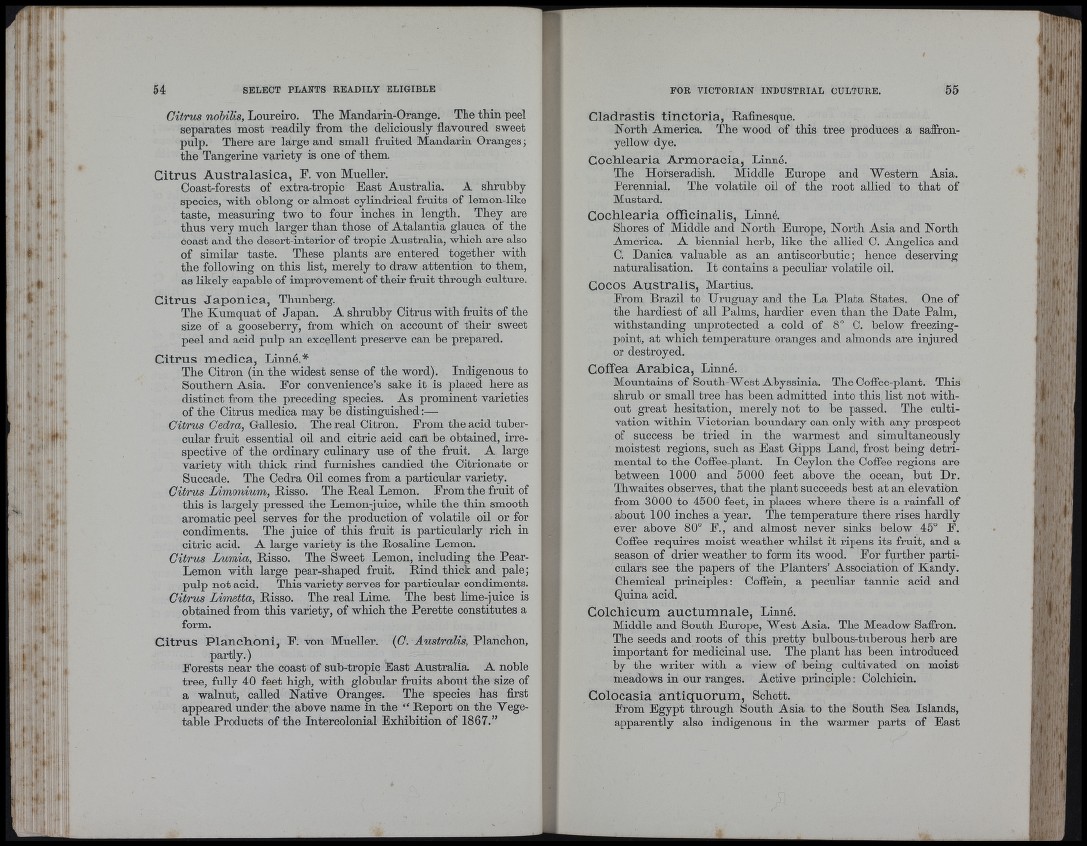
yf '
i "
: il
1 ' :
5 4 SELECT PLANTS READILY ELIGIBLE
Citrus nobilis, Loureiro. The Mandarin-Orange. The thin peel
separates most readily from the deliciously flavoured sweet
pulp. There are large and small fruited Mandarin Oranges;
the Tangerine variety is one of them.
Citrus Australasica, F. von Mueller.
Coast-forests of extra-tropic East Australia. A shrubby
species, with oblong or almost cylindrical fruits of lemon-like
taste, measuring two to four inches in length. They are
thus very much larger than those of Atalantia glauca of the
coast and the desert-interior of tropic Australia, which are also
of similar taste. These plants are entered together with
the following on this list, merely to draw attention to them,
as likely capable of improvement of their fruit through culture.
Citrus Japónica, Thunberg.
Tbe Kumquat of Japan. A shrubby Citrus with fruits of the
size of a gooseberry, from which on account of their sweet
peel and acid pulp an excellent preserve can be prepared.
Citrus medica, Linné.*
The Citron (in the widest sense of the word). Indigenous to
Southern Asia. For convenience’s sake it is placed here as
distinct from the preceding species. As prominent varieties
of the Citrus medica may be distinguished:—
Citrus Cedra, Gallesio. The real Citron. From the acid tubercular
fruit essential oil and citric acid can be obtained, irrespective
of tbe ordinary culinary use of the fruit. A large
variety with thick rind furnishes candied the Citrionate or
Succade. Tbe Cedra Oil comes from a particular variety.
Citrus Limonium, Risso. The Real Lemon. From the fruit of
this is largely pressed the Lemon-jnice, while the thin smooth
aromatic peel serves for the production of volatile oil or for
condiments. The juice of this fruit is particularly xich in
citric acid. A large variety is the Rosaline Lemon.
Citrus Lumia, Risso. The Sweet Lemon, including the Pear-
Lemon with large pear-shaped fruit. Rind thick and pale;
pulp not acid. This variety serves for particular condiments.
Citrus Limetta, Risso. The real Lime. The best lime-juice is
obtained fi-om this variety, of which the Perette constitutes a
form.
Citrus Planchoni, F. von Mueller. {G. Aiistralis, Planchón,
partly.)
Forests near the coast of sub-tropic East Australia. A noble
tree, fully 40 feet bigb, with globular fruits about the size of
a walnut, called Native Oranges. The species has first
appeared under the above name in the “ Report on the Vegetable
Products of the Intercolonial Exhibition of 1867.”
FOR VICTORIAN INDUSTRIAL CULTURE. 55
i» ' i*, \
‘ .
Cladrastis tinctoria, Rafinesque.
North America. The wood of this tree produces a safiron-
yellow dye.
Cochlearia Armoracia, Linné.
The Horseradish. Middle Europe and Western Asia.
Perennial. The volatile oil of the root allied to th a t of
Mustard.
Cochlearia officinalis, Linné.
Shores of Middle and Noi-th Europe, North Asia and North
America. A biennial herb, like tbe allied C. Angelica and
C. Danica valuable as an antiscorbutic; hence deserving
naturalisation. I t contains a peculiar volatile oil.
Cocos Australis, Martins.
From Brazil to Uruguay and tbe La Plata States. One of
the hardiest of all Palms, hardier even than the Date Palm,
withstanding unprotected a cold of 8° C. below freezing-
point, at which tempex-ature oranges and almonds are injured
or destroyed.
Coffea Arabica, Lixmé.
Mountains of South-West Abyssinia. Tbe Cofiee-plant. This
sbrub or small tree bas beexx admitted into this list not without
great hesitation, merely not to be passed. The cultivation
within Victoxian boundary caxx only with any prospect
of success be tried ixx the warmest and simultaneouslv«
/
moistest regions, such as East Gipps Land, frost being detrimental
to the Cofiee-plant. In Ceylon the Coffee regions are
between 1000 and 5000 feet above the ocean, but Dr.
Tbwaites observes, that the plant succeeds best at an elevation
from 3000 to 4500 feet, in places where there is a rainfall of
about 100 inches a year. The temperature there rises hardly
ever above 80° E., axxd almost never sinks below 45° F,
Cofiee requires moist weather whilst it xipens its fruit, and a
season of drier weather to form its wood. Eor fqrtber particulars
see the papers of the Plaixters’ Association of Kandy.
Chemical principles: Cofiein, a peculiar tannic acid and
Quina acid.
Colchicum auctumnale, Linné.
Middle and South Europe, West Asia. The Meadow Safix’on.
The seeds and roots of this pretty bulbous-tuberous herb are
important for medicinal use. The plant has been introduced
by the writer with a view of beixxg cultivated on moist
meadows in our ranges. Active principle : Colchicin.
Colocasia antiquorum, Schott.
From Egypt through South Asia to the South Sea Islands,
apparently also indigenous in the warmer parts of East
III
1 * I
-.i'
t
•I
Iv
It